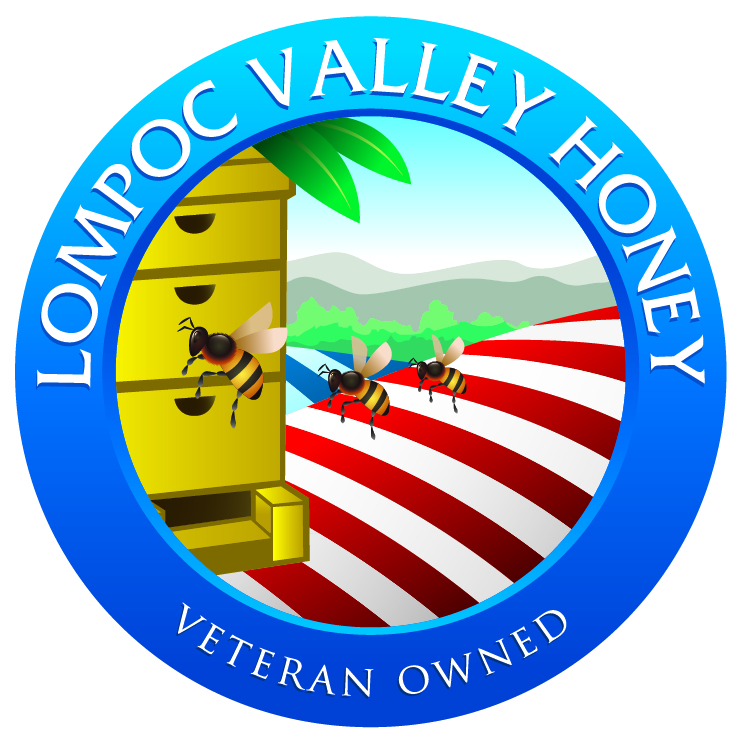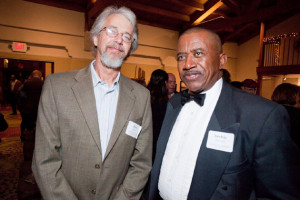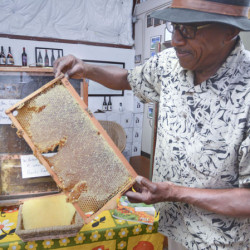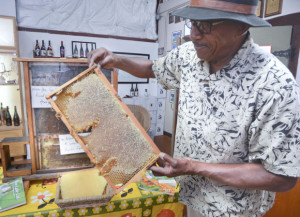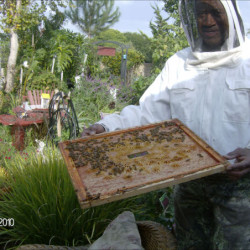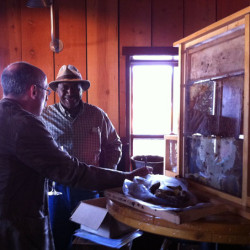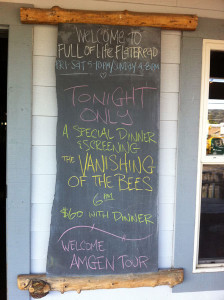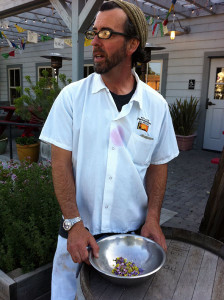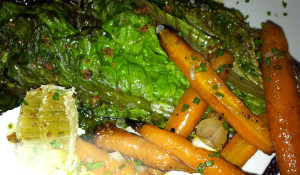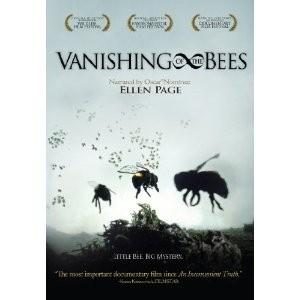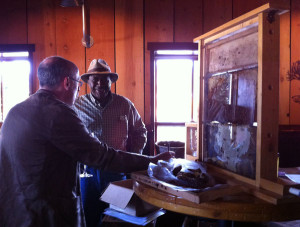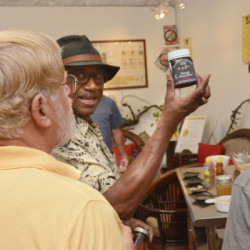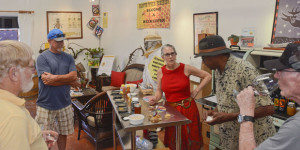Sticky situation
Area honey bees persevere despite challenges
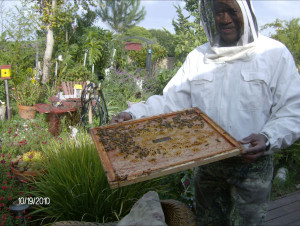 Dressed in a white beekeeping suit, Archie Mitchell, a beekeeping professor at Allan Hancock College and 30-year veteran of the trade, opens one of the hives situated in a park across the road from the college’s Lompoc campus.
Dressed in a white beekeeping suit, Archie Mitchell, a beekeeping professor at Allan Hancock College and 30-year veteran of the trade, opens one of the hives situated in a park across the road from the college’s Lompoc campus.
“See down there,” Mr. Mitchell says, opening up the box that contains the hive, motioning toward a series of tiny hexagonal cells. “There’s your honey. These are the cells the worker bees are currently working on filling.”
The tiny ampoules of honey glisten in the sun as Mr. Mitchell tilts the honeycomb. He then offers a piece of honey-drenched honeycomb. Rich, sweet and thick — and as local as it gets — the honey has a flavor all its own.
“This is a wildflower honey,” Mr. Mitchell explains. “The bees are foraging around the park here, where there’s a lot of local wildflowers. Right now, they’re mostly feeding off of native buckwheat, but there’s other nectar mixed in there too.”
Producing honey is hard work, for the bees and keepers alike. And it’s getting harder all the time.
Worldwide populations of pollinating insects are declining, honeybees included. In 2006, after disappearances of Western honeybee colonies drastically increased in North America, the phenomena was labeled Colony Collapse Disorder. Pesticides, pathogens, monoculture diets, declining genetic diversity, genetically modified crops and electromagnetic radiation have all been touted as contributing causes. Population decline here in the West is further exacerbated by the drought.
“The drought is affecting the bees in a lot of different ways,” Mr. Mitchell says. “It’s affecting the flowers and the amount of nectar they produce. We add water to the hive for the bees, but that’s causing problems too. Other insects like ants are suffering so they’re going into the hives looking for water. We have a problem with hornets too. They will actually go into the boxes and take them over.”
Honeybee colonies are also being infected with a tiny parasite called the varroa mite. Once infected, a colony can be wiped out in 18 months.
It is story recounted across the region, and while local bees are still making honey, they are making a lot less of it, as reported in the Sept. 14 News-Press.
Mr. Mitchell is one of about a dozen honey producers in the area. He started keeping bees in Lompoc about 30 years ago and sells his honey both online and at the Lompoc farmers market. It comes in 8- and 24-ounce glass jars for $7 and $12, respectively. Archie’s Honey has only one variety available, local wildflower, due to the hives not being moved from their current location. He previously kept them on Vandenberg Air Force Base.
“I had to move them a few months ago,” Mr. Mitchell says. “They told me I couldn’t keep them there anymore because of the endangered El Segundo blue butterfly. You can have bees on the lawn of the White House, but you can’t keep them on Vandenberg Air Force Base. There’s 100,000 pesticide-free acres out there and the butterfly is only in 15,000 of it. That doesn’t make sense to me.”
Out on State Route 246, just before you reach Buellton from Lompoc, you pass a field of lavender that Cheryl Andre Wagner has been farming with her son, Tim, for 10 years. The family grows and harvests the herb for its oil that they extract and age on the property. As well as making a variety of lavender-scented products, Andre Lavender also produces its own lavender honey.
“We have two hives out there in the field,” Ms. Wagner tells the News-Press. “The bees pollinate the lavender and we hire a local beekeeper to look after the hives. He extracts the honey and brings it back to us in containers for bottling.”
Unique in taste, with distinct hints of the herb, one customer suggests drizzling lavender honey over feta cheese or into a cup of hot tea. Price for the honey is $8.50 for 3.7 ounces and $12.50 for 6.4 ounces.
Closer to Santa Barbara, Don and Anne Cole own and operate Goleta-based San Marcos Farms Honey Co. The couple have been harvesting and handcrafting a variety of local honeys for more than 20 years and have been selling their products at local farmers markets, including those in Goleta and Santa Barbara, since the 1980s. Prices range from $6 for 8 ounces to $22 for 48 ounces.
Mr. Cole maintains hundreds of hives and in February starts moving them around the region to be in place for the bloom of different plant species.
He first takes hives to the San Joaquin Valley to pollinate almond orchards and then places hives in the Santa Barbara backcountry for the bees to feast on local wildflower nectar, like sage and California buckwheat. He takes them to Goleta for eucalyptus, Carpinteria for avocado and Ojai for citrus. This allows for each honey to have its own flavor profile. But it is not always an exact science.
“All depends on nature; certain years are better for certain types of honey,” Mr. Cole says. “Rainfall plays a big role in that. Because of the drought, things have been pretty slim in terms of honey production. So at the moment, it’s a matter of making the most of what we can get.”
The bees also have a say in what they are producing. Brian Cox of Ojai Valley Bee Farm sells honey at the Ventura and Ojai farmers markets. It ranges from $6 for 8 ounces to $14 for 32 ounces. His orange and avocado varieties are sourced from Ojai farms while wildflower, buckwheat and sage varieties come from the backcountry.
“You can put the hives right in the middle of a certain bloom, but it doesn’t mean that’s what the bees will feed on,” says Mr. Cox with a knowing chuckle, adding that he often has to relocate the hives. “Avocados and oranges bloom at the same time, but the bees prefer the oranges because they can get more nectar. It’s less work for them so they often bypass the avocado flowers.”
That preference is good news for Friend’s Ranches in Ojai, which specializes in citrus. The Friend family started farming in the area in the late 1800s and the Thacher and Ayala families, descendants, grow different varieties of oranges, tangerines (including the famed Pixie), mandarins, grapefruits and lemons. Friend’s Ranches produces a citrus and wildflower honey that sells at the Saturday Santa Barbara farmers market. It retails for $8 for 16 ounces and $19 for 48 ounces.
“Honey is a sideline to our citrus, but it’s expensive right now and it should be because there’s not enough of it around,” says Emily Ayala, co-owner of Friend’s Ranches. “The last two springs have been dry and the flowers are producing plenty of pollen, but the nectar is not as abundant and dries up quickly.
“People are attributing the decline of bees on a number of things, but for us here in the western United States, the biggest fact is that it just hasn’t rained.”
email: life@newspress.com
WHERE TO BUY
Andre Lavender: 350-0593 or www.andreorganiclavender.com
Archie’s Honey: 291-3279 or www.lompochoney.com
Friend’s Ranches: 646-2871 or www.friendsranches.com
Ojai Valley Bee Farm: 646-2056 or www.ojaivalleybeefarm
San Marcos Farms Honey Co.: 681-0312 or www.sanmarcosfarms.com
BRETT LEIGH DICKS, NEWS-PRESS CORRESPONDENT
September 18, 2014 6:47 AM
